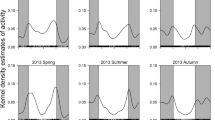Abstract
FROM more than a hundred liberations, between 1851 and 1923, red deer have spread into the majority of forested areas in New Zealand. In the present communication autumn fawn/hind ratios in New Zealand are compared between five different areas and within each area on two successive years, 1952 and 1953.
This is a preview of subscription content, access via your institution
Access options
Subscribe to this journal
Receive 51 print issues and online access
$199.00 per year
only $3.90 per issue
Buy this article
- Purchase on Springer Link
- Instant access to full article PDF
Prices may be subject to local taxes which are calculated during checkout
Similar content being viewed by others
References
Fisher, R. A., “Statistical Methods for Research Workers” (Oliver and Boyd, 1950).
Riney, T., N.Z. J. Sci. and Tech., 36, B, 5, 429 (1955).
Alex-Hansen, Børge, Dansk Jagttidende, 67, 170 (1950).
Darling, F. F., “A Herd of Red Deer. A Study in Animal Behaviour” (Oxford, 1937).
Müller-Using, D., “Grundlagen moderner Jagdwirtschaft” (Krogers Verlagsanstalt, 1949). Review by Westerskov, K., J. Wildl. Mgt., 17, 84 (1953).
Author information
Authors and Affiliations
Rights and permissions
About this article
Cite this article
RINEY, T. Differences in Proportion of Fawns to Hinds in Red Deer (Cervus elaphus) from Several New Zealand Environments. Nature 177, 488–489 (1956). https://doi.org/10.1038/177488a0
Issue Date:
DOI: https://doi.org/10.1038/177488a0
This article is cited by
-
Sex Ratios in Marsupial Pouch Young
Nature (1964)
-
Early Fertility of Red Deer Hinds in New Zealand
Nature (1963)
Comments
By submitting a comment you agree to abide by our Terms and Community Guidelines. If you find something abusive or that does not comply with our terms or guidelines please flag it as inappropriate.



